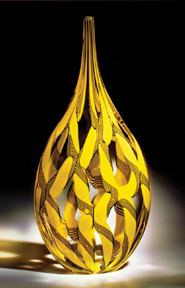
 |
MURANO
MAGIC |
Excerpts from Murano Magic :
|
Chapter 3. Glass Terminology (excerpt) Marketing strategy has made the terminology of Murano glass more complicated than it needs to be. Different glassworks often invent their own proprietary term for a technique widely used by other glassworks under different names. In the same way, new styles are often named as though they represented new processes. Despite the confusion, an understanding of some basic terms is essential for appreciating Murano glass and benefiting from the literature surrounding it. The glossary below introduces the principal processes as well as certain additional terms that have acquired wide usage. * * * Chapter 4. Glassmakers of Murano (excerpt) The glassmaking firms of Murano are constantly in motion: opening, closing, merging, splitting up, reorganizing, changing names. At the same time, designers and other specialists--both famous and obscure--move back and forth among the glassmakers at different points in their careers, a few of them with more than a dozen stops. A new organizational pattern is introduced here for following these people and firms. The object is to create a unified database that allows the user to find a path through the constantly changing Murano world. The Index to Glassmakers includes the multiple names of many of the art glass producers who have operated on Murano or elsewhere in Venice prior to the early 1990s. All of the indexed firms are profiled. Separate development profiles are provided for 29 of them; the others are described as part of the individual profile of their principal proprietor. Subject to some exceptions, particularly in the case of early glassmakers, the table does not include firms outside of Murano and Venice or those primarily devoted to beads or other utilitarian glassware. * * * Chapter 6. Reference Library (excerpt) Any collection is more rewarding if the collector takes time to become familiar with the literature surrounding it. No field illustrates this better than Murano glass. Although nothing can replace the experience of actually viewing and handling a variety of pieces produced by different makers at different times and of discussing them with knowledgeable dealers, few have an opportunity to educate themselves about Murano glass in that way alone. Everyone will become a more appreciative, knowledgeable and confident collector by acquiring and studying a few of the key books in the field. They will learn to recognize some of the products of different glass producers and their legendary entrepreneurs, glassblowers and designers, and they will understand the key factors affecting the value of individual pieces. The wide variety of beautiful books on Murano glass is both a blessing and a curse. On the one hand, it means that a great deal of information is available but, on the other, it can be difficult for the newcomer to know where to begin. Here are some suggestions, most of which are bi-lingual or available in English. * * * Copyright 2004 Carl I. Gable All rights reserved. |
